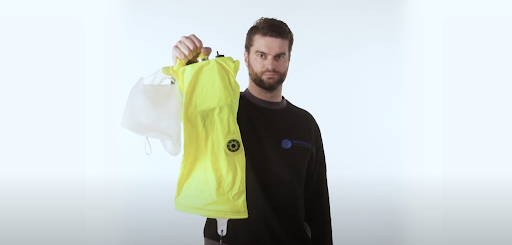Written by: Stuart McOnie, Founder and General Manager
Table of Contents:
Summary
What is an EEBD?
How are EEBDs used?
What does Semmco LPS think?
What Industries Use EEBD?
The Different Types of EEBD
Why Choose the Semmco EEBD
Summary:
- An Emergency Escape Breathing Device (EEBD) provides breathable air in contaminated or oxygen-deficient environments, allowing for a safe escape in case of emergency. It is a self-contained apparatus typically offering 10 to 30 minutes of respiratory protection.
- EEBDs are extensively used in maritime and other industrial workplaces. For example, they are required on ships and in many industrial plants to manage the risk of sudden air quality deterioration.
- EEBDs are critical for safety compliance in potentially hazardous workplaces. They ensure workers’ ability to breathe during an emergency escape by providing respiratory protection against the risks of asphyxiation and inhaling toxic gases or smoke.
If you work in a hazardous environment where the air can become unsafe to breathe, an Emergency Escape Breathing Device (EEBD) can act as a crucial lifeline. Designed to swiftly provide a short-term supply of breathable air, EEBDs are indispensable across many industries. In this article, we discuss what EEBDs are, their usage, and the different types available.
What is an EEBD?
Simply put, an Emergency Escape Breathing Device (EEBD) is a supplied air or oxygen device used to escape hazardous atmospheres in the workplace.
Whether inundated with toxic gases, smoke, or otherwise lacking oxygen, these atmospheres are often in a confined environment and pose immediate threats to health and safety. EEBDs provide a swift means of escape.
Bear in mind that EEBDs are not intended for firefighting or prolonged use but rather to facilitate rapid evacuation from a contaminated or oxygen-deficient environment.
How to use EEBDs
An EEBD is typically a compact and lightweight unit that ensures a steady flow of breathable air or oxygen to the wearer. Here is how one popular type of EEBD, the chemical oxygen rebreather, works:
- As the wearer dons the EEBD, they activate the device, initiating the release of oxygen or supplied air.

2. This airflow is typically channelled through a loose-fitting hood that envelops the wearer’s head, creating a sealed environment.

3. This design ensures a continuous supply of breathable air, protects the wearer’s eyes, and allows for clear vision, which is essential for navigating to safety.
When you’re in a dangerous situation, the safety solution needs to be simple and easy to use under pressure. EEBDs are engineered for ease of use, with intuitive activation mechanisms that require minimal training.
In an emergency, the wearer simply retrieves the EEBD from its storage location, dons the equipment and activates the device, instantly providing breathable air for safe evacuation.
 What does Semmco LPS think?
What does Semmco LPS think?
“We have seen the safety of workers in hazardous environments improve significantly in recent years, and it’s in no small part due to the availability of quality emergency escape devices. Emergency Escape Breathing Devices (EEBDs) are essential not just for compliance, but for providing a lifeline in critical situations. The presence of reliable EEBDs saves lives and gives workers the confidence to perform their duties knowing they are protected.” Richard Young, Business Development Manager, Semmco LPS
What industries use EEBD?
The biggest demand for EEBDs is for industries such as manufacturing, water, marine and rail, that extensively rely on these devices to ensure the safety of their workforce and provide a critical means of escape. They are most commonly used, and often legally required, for the following sectors:
- Maritime and Offshore Industry
- Chemical and Petrochemical Industries
- Mining and Tunnelling
- Nuclear Facilities
- Aerospace
- Manufacturing Industries
- Railways
Remember that you may legally require an EEBD Device. It’s important to establish whether there are any EEBD regulations for your specific sector or workplace. The key aspects of these laws typically include requirements for the availability, maintenance, and training in the use of EEBDs. Here are two examples:
- For Ship – International Maritime Organisation (IMO): Per the Safety of Life at Sea (SOLAS) convention Chapter II-2, commercial ships must have at least two emergency escape breathing devices within their accommodation spaces, and everyone on board should know how to use them in an emergency.
You can review the specific maritime EEBD according to SOLAS here.
- For Rail – US Federal Railroad Administration (FRA): In the US, the FRA has ruled on the new Emergency Escape Breathing Apparatus Standards, which require railroads to supply an EEBD to every train crew member in the locomotive cab on a freight train transporting material that might pose a breathing hazard if they were released during an accident.
You can read the complete regulatory update on EEBD by the FRA here.
The Different Types of EEBD
EEBDs come in various types, each using a different method to provide breathable air to its wearer:
- Autonomous Breathing Gas Supply: These EEBDs carry a calculated supply of breathing gas for escape within a designated timeframe.
- Rebreathers: Rebreathers use chemical oxygen generation to recycle exhaled air, removing carbon dioxide and replenishing oxygen, thereby extending endurance. The Semmco EEBD, available in 15- and 20-minute durations, is an example of an oxygen rebreather.

3. Open Circuit Escape Breathing Apparatus: Available in positive pressure or constant flow variants, these EEBDs provide compressed air from a cylinder.
EEBDs also come in different durations, typically between 10 and 30 minutes, to allow enough time to reach safety.
Which type do you need? This choice should be based on a thorough risk assessment carried out by an expert, considering factors like the specific risks, environments and evacuation routes in your workplace to ensure enough breathing time for a safe escape.
Why Choose the Semmco EEBD?
With versions offering durations of 15 or 20 minutes, Semmco EEBDs guarantee ample time for a safe escape:
| Product | Specification |
| Marine 15 EEBD |
|
| Industrial 20 EEBD |
|
Featuring a unique system using KO2 (potassium superoxide), Semmco EEBDs efficiently absorb exhaled CO2, liberating oxygen for the user. This innovative approach ensures continuous oxygen generation throughout the escape process.
Moreover, Semmco EEBDs have an impressive shelf life of up to 15 years, providing long-term reliability, peace of mind and lower through-life costs. Regular visual checks ensure their readiness for immediate use when the situation demands.
EEBDs play an indispensable role in safeguarding workers’ lives in hazardous conditions, and with Semmco LPS, you’re investing in performance and, most importantly, the safety of your workforce. If you’re interested in learning more or would like to discuss your requirements in detail, reach out to our expert team at https://semmcolps.com/contact/.
Related Reading:
- Read more about the legal requirements of EEBD

